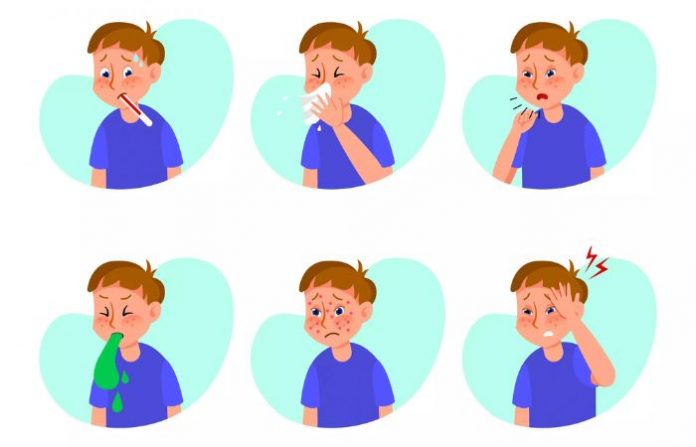Measles is a highly contagious virus transmitted through respiratory droplets or by touching a surface infected with measles and then touching your mucous membranes.1
Up to two hours after a contaminated individual leaves an area, the measles virus can remain contagious in the air.2 Measles primarily affects children and, in some cases, can be fatal.
Thankfully, the measles vaccination has helped prevent many deaths.
How contagious is the measles?
Before the preventative vaccine, measles was a significant public health concern for many years.
Measles in Canada is no longer a significant concern; however, outbreaks can happen when an unvaccinated or under-vaccinated individual travels to a region with a measles outbreak and brings the virus back to their home country.3
Despite vaccination, measles still seriously threatens some regions worldwide as the vaccine protocols are not always adhered to or the vaccine is unavailable.
Signs and symptoms of measles
Signs and symptoms of measles can appear 7-14 days after exposure.
A person is considered contagious four days before the rash appears and four days after.1
Signs and symptoms of measles typically include:
- fever,
- cough,
- runny nose,
- rash,
- pink eye,
- and Koplik spots are white-blush spots on the inside of the cheek.1
Typically, patients are considered contagious from about four days before the rash appears and four days after the rash appears.2
How is measles diagnosed?
Assessment should be done if typical measles symptoms like a rash or a fever are present and there has been international travel or exposure to another person who has traveled internationally.
Laboratory tests can confirm a measles diagnosis.
Healthcare providers typically use blood or tissue tests from a throat or nose swab to detect the virus.2
Additionally, a urine test can help detect the virus.
Complications of measles
Measles can lead to pneumonia, sores in the mouth, diarrhea, ear infections, and upper respiratory tract infections.2
Uncommon side effects of measles are neurological impairments, including acute encephalitis, inflammation of the brain’s active tissues, or subacute sclerosing panencephalitis (SSPE).2 SSPE is rare, however, in some cases, could lead to intellectual decline and seizures 7-10 days after measles infection.2
Those at greatest risk of complications include immunocompromised, pregnant, or unvaccinated individuals younger than five or older than 20.1
If measles is contracted during pregnancy, it may lead to premature labor and low birth weight for the baby.1
How can measles be prevented?
Measles can be prevented with the MMR (measles, mumps, and rubella) vaccine.4
The measles vaccine is a combination that also protects against mumps and rubella. It offers enduring immunity to the virus and is highly effective. It can also be given in combination with the varicella (chickenpox) vaccine.
Two doses of the MMR vaccine need to be given and are typically recommended regardless of whether the first dose works.4
Two doses of measles vaccination are 97% effective at preventing infection, whereas one dose is only 93% effective.4
Treatment of measles
Currently, no proven antiviral medications display effective treatment against measles.1 Those who become infected should be isolated and observed closely for complications.
For children who become hospitalized with measles, the CDC recommends using vitamin A supplements.2
Those who have not been vaccinated should receive the MMR vaccine within a few days of being infected.1,2
How common is measles?
While measles outbreaks are uncommon in areas with high vaccination rates, they are still possible when vaccination rates decrease. International travel can also spread the illness to new populations that lack immunity.
To prevent the spread of measles, it is vital to maintain high immunization rates for individuals to protect themselves and their communities.
References
- Walter K, Malani PN. What Is Measles? JAMA. 2022;328:2370-2370. doi:10.1001/jama.2022.21363
- For healthcare professionals – diagnosing and treating measles. Centers for Disease Control and Prevention. https://www.cdc.gov/measles/hcp/index.html. Published November 5, 2020.
- Measles in Canada. Government of Canada. Canada.ca. https://www.canada.ca/en/public-health/services/diseases/measles/measles-in-canada.html#. Published April 1, 2019.
- Vaccine for measles (MMR shot). Centers for Disease Control and Prevention. https://www.cdc.gov/measles/vaccination.html. Published November 5, 2020.



